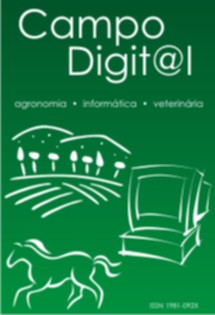LEVANTAMENTO DE COLEÓPTEROS EM MATA NATIVA E NA CULTURA DE MILHO
Palavras-chave:
armadilha de solo, Coleoptera, fatores abióticosResumo
O presente trabalho teve por objetivo a identificação das principais famílias de coleópteros existentes em uma mata nativa próxima a áreas agricultáveis e destacar a influência de fatores abióticos na distribuição dos mesmos. O levantamento foi realizado no município de Sete Lagoas, MG, em uma área de Mata Atlântica nativa próxima a uma cultura de milho. As amostragens foram também realizadas em um corredor entre as duas áreas para avaliar a transição dos insetos. Em cada área foram distribuídas nove armadilhas de queda do tipo “pitfall”, e no corredor havia cinco armadilhas. As armadilhas continham água (700 ml) e detergente (10 gotas), sendo substituídas semanalmente. As coletas foram realizadas no verão/outono (15/03 à 11/04) e no inverno (05/07 à 02/08) do ano de 2013. Os insetos foram montados e catalogados em caixa entomológica e identificados ao nível de família. A amostragem no verão/outono apresentou maior abundância (138 indivíduos) e diversidade (12 famílias), sendo as mais representativas Staphylinidae (28,3%), Coccinellidae (24,6%), Scarabaeidae (23,9%) e Dasytidae (13,0%). A amostragem no inverno apresentou menor abundância (103 coleópteros) e diversidade (10 famílias), com destaque para as famílias Tenebrionidae (62,1%), Staphylinidae (17,9%) e Nitidulidae (9,7%). A temperatura e a precipitação pluviométrica demonstraram-se influenciadores na distribuição de coleópteros na área entre a mata e a área cultivada com o milho. Infere-se que as famílias de coleópteros diferem-se em relação à adaptabilidade às estações do ano e que cada uma delas com suas características morfológicas e fisiológicas, habitam as diferentes áreas analisadas demonstrando capacidade de adaptação e busca pela sobrevivência.
Palavras chaves: armadilha de solo; Coleoptera; fatores abióticos.
Abstract
This study aimed to identify the main families of beetles exist in a native forest near agricultural areas and highlight the influence of abiotic factors on their distribution. The survey was conducted in an area of native rainforest and nearby a maize crop. Samples were also performed in a hallway between the two areas to assess the transition of insects. In each area were distributed nine pitfall traps, except for the hallway where there were five traps. The traps contained 700 ml of water and 10 drops of detergent, replaced weekly. The collections were made in the summer/autumn and winter of 2013. Insects were separated, assembled in entomological box and submitted to identification to the family level. Sampling in summer showed higher abundance (138 individuals) and diversity (12 families), being Staphylinidae (28.3%), Coccinellidae (24.6%), Scarabaeidae (23.9%) and Dasytidae (13.0%), the families most representative. Sampling in winter showed lower abundance (103 beetles) and diversity (10 families), highlighting the Tenebrionidae (62.1%), Staphylinidae (17.9%) and Nitidulidae (9.7%) families. The temperature and the rainfall showed to be affect the beetles’ distribution between the forest and the crop. It is inferred that the families of beetles differ in relation to adaptability to seasons and each with their morphological and physiological characteristics, inhabit different areas analyzed demonstrating adaptability and search for survival.
Key words: abiotic factors; Coleoptera; pitfall trap.
Downloads
Publicado
Como Citar
Edição
Seção
Licença
Direitos Autorais para artigos publicados nesta revista são cedidos pelo autor à Revista Campo Digital, que está autorizada a publicá-lo em meio impresso, digital, ou outro existente, sem retribuição financeira para os autores. Em virtude da aparecerem nesta revista de acesso público, os artigos são de uso gratuito, com atribuições próprias, em aplicações educacionais e não-comerciais.










 ISSN 1981-092X
ISSN 1981-092X
